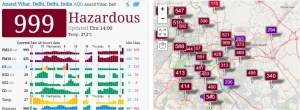The thick haze that shrouded Delhi’s sky on Thursday painted an eerie picture reminiscent of an apocalyptic scenario. The city’s landmarks were obscured by the heavy smog, making it difficult to discern even nearby buildings.
For the third consecutive day, many parts of Delhi found themselves grappling with air quality in the ‘hazardous’ zone. According to the weather agency aqicn.org, Delhi’s Anand Vihar registered an astonishing air quality index (AQI) of 999, while Noida’s Sector 62 reported a still alarming AQI of 469. Across many areas in Delhi, the AQI soared above 500, as reported by aqicn.org.
Read More: Big News! Zika Virus Detected Near Bengaluru, Alert Issued
Scientists are sounding the alarm due to a surge in farm fires and unfavorable weather conditions, warning of a potential spike in pollution levels in the Delhi-NCR region over the next two weeks. This is particularly concerning considering that the air quality index in many areas has already surpassed the 400 mark.

Health experts are apprehensive about a potential increase in asthma and respiratory problems, especially among vulnerable groups such as children and the elderly.
As of 10 am (according to SAFAR data), the city’s Air Quality Index (AQI) was recorded at 351. The 24-hour average AQI stood at 364 on Wednesday, 359 on Tuesday, 347 on Monday, 325 on Sunday, 304 on Saturday, and 261 on Friday.
Several areas within the city, including Punjabi Bagh (416), Bawana (401), Mundka (420), and Anand Vihar (413), reported air quality falling into the severe category. The concentration of PM2.5, fine particulate matter that can deeply penetrate the respiratory system upon inhalation, was six to seven times higher than the safe limit of 60 micrograms per cubic meter in these locations.
Read More: Kissed, Stripped, Clicked! IIT-BHU Student’s Molestation Sparks Outrage
In response to the deteriorating air quality, Delhi Environment Minister Gopal Rai announced a ban on construction work in areas that record an air quality index (AQI) above the 400-mark for five consecutive days. Additionally, the government has launched the “Red Light On Gaadi Off” campaign to reduce vehicular pollution and plans to introduce 1,000 private CNG buses to bolster public transport and curb vehicular emissions.
The neighboring regions of Delhi also faced severe air quality concerns, with an AQI of 230 in Ghaziabad, 324 in Faridabad, 230 in Gurugram, 295 in Noida, and 344 in Greater Noida.
The current situation underscores the dire air quality challenge in the Delhi-NCR region, exacerbated by unfavorable meteorological conditions and a mix of emissions from firecrackers, paddy straw burning, and local sources of pollution, particularly during the winter season.
As per an analysis by the Delhi Pollution Control Committee (DPCC), the capital experiences peak pollution from November 1 to November 15, coinciding with a rise in stubble burning incidents in Punjab and Haryana.
To address this, the Punjab government is striving to reduce farm fires by 50 percent this winter season and eliminate stubble burning in six districts. Haryana, on the other hand, is committed to nearly eliminating farm fires this year. Both states face the challenge of managing significant volumes of paddy straw generated from non-basmati rice cultivation, which has been a major contributor to the problem.